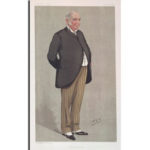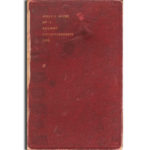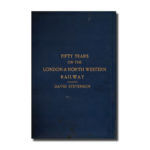Description
The “Grouping” of the railways was not well planned, and was carried through in far too much of a rush. There are accounts of the committee charged with drafting the legislation, was continually interrupted by “messages from upstairs” – the Minister for Transport, Sir Eric Geddes – posing detailed questions and requiring last-minute changes.
Of all the four groups, the composition of the LMS was the least well thought out and confusion was inherent from the beginning. The prior amalgamation of the LNWR and the L&Y the year before vesting day was ill-advised, in that the LNWR was already recognised as the largest joint stock undertaking in the world. In addition it had placed large share issues on the stock market, which were snapped up by investors. The company had long recognised that it was too big to micromanage, and had a devolved system of government rather like the British Empire, with the Imperial government at Euston and “dominions” and “colonies” – divisions and districts, for different functions throughout the system, some based closely on the territories of companys which it had absorbed, each enjoying a degree of autonomy, administered by “conferences” of the local officers concerned..
The process of melding the L&Y into the organisation had only just begun, when the bigger Grouping took place, throwing all into the melting pot. The LNWR had suffered from premature deaths , and early retirements due to ill health amongst its senior officials. They new appointees were junior in terms of service to their opposite numbers from the L&Y. “Buggins’ turn” therefore operated, and top jobs therefore went to men with longer service from the much smaller railway. This was particularly unfortunate in the appointment of George Hughes, with only a few years to go before retirement, from the L&Y as Chief Mechanical Engineer, at the expense of the very capable and much younger Hewitt Beames CME of the LNWR. Also passed over was Sir Henry Fowler, CME of the Midland Railway, a gas engineer, metallurgist and first class production engineer, who had spent part of the Great War running the Royal Aircraft Establishment at Farnborough. But a locomotive engineer he was not. He owed his appointment to the fact that Granet, General Manager, MidlandRailway (later Chairman, LMS) did not want a “prima donna” as CME, argumentative, and full of expensive ideas. In Sir Henry, he got his man, a devout Christian, running a Sunday afternoon bible class, a football team, a cricket team and a pillar of the Boy Scout movement and sitting on the committees or boards of so many professional and educational bodies, it was a wonder he has time to go to work at all.
At the Grouping, both Fowler and Beames (together with further LNWR officers) were passed over again, the LMS appointing Hughes as CME. Hughes refused to move his office from Horwich “at the end of a branch line in Lancashire” and was not in close touch with events in the main locomotive works at Derby, Crewe and St. Rollox, nor was he in touch with high policy being discussed at Euston. He eventually retired in 1925, having achieved little, but setting a tone in the department which resulted in little technical development, and as Fowler eventually succeeded him, a policy of building small obsolecent locomotives of basic Midland design.
The same confusion permeated the rest of the railway. The General Manager left, and Chairman Granet, who at least in part was responsible, wanted to leave too to spend more time in the City, looking after his money. His solution was to recruit a noted economist, Sir Josiah Stamp to a post common in America, uncommon in Britain “President of the Executive”. This would consist of Stamp, and three Vice Presidents, who between them would exercise powers of general management. Stamp in addition would chair the board of directors, who increasingly found themselves as little more than a rubber stamp. It was an attempt for four men to micromanage a huge undertaking through the chief officers, economies of scale, and rationalisation. It was expected that it would take ten years to achieve success. In fact, faced with dropping traffic and receipts in a period of sump, followed by depression, they opted to go for the “low hanging fruit” of economies in the use of paper – letters were sent out typed on the back of old correspondence, the LMS lead in the quality of advertising was slowly squandered by publishing material on cheap paper,.Cleaning schedules for stations and carriages were cut back, apparently abandoned altogether in the case of smaller stations, while waiting room fires were no longer lit in the winter, and a programme of station and line closures embarked upon It was a policy described by one railway writer as “Retrenchment and Despair”. The basic organisational and managemenr problems reained largely neglected. The LMS became a grubby looking railway, with a reputation for poor timekeeping and demoralised staff. Stamp my have been a first class economist, but his experience of railways had been limited to sitting on a commission to reorganise the German railways after the Great War. His policies sidelined the directors, many of whom had years of railway and business experience, and cut them of from direct contact with departmental chief officers.
Matters at last changed in 1931, when Sir Henry Fowler was shunted off into a research job, and Ernest (later Sir Ernest) Lemon was appointed CME. (A highly experienced production engineer, he was loaned to the Government in 1938, as Director of Aircraft Production at a time when there was barely a squadron of Hurricanes in service, and Supermarine thought it might be possible to build one Spitfire a week). Lemon thoroughly undertook a long needed overhaul of the CME department, including making Beames Deputy CME based at Derby. The new organisation was up and running when William Stanier (later Sir William) arrived from the Great Western Railway in 1932, to take over as CME when Lemon was appointed as a Vice President. He then he applied his analytical mind to the rest of the LMS problems
Between them Lemon and Stanier began to pull the LMS round. Lemon had made a significant difference by the time he was seconded to the Ministry, which he left in 1940, having been largely responsible for sufficient Hurricanes and Spitfires to be available for the Battle of Britain. Always somewhat neurotic, succumbing to bouts of ill health due to overwork. Lemon returned to the LMS and continued to try for reforms, but his health had been permanently damaged and he was persuaded to take early retirement, with a package that not only paid his pension in full, but also compensated for the loss of earnings caused by early retirement.
This document illustrates with tables and bar charts the fluctuations in the fortiunes of the LMS
From Grouping until 1946.
Interestingly, it does not bear the imprimature of the Executive Research Office which rigorously controlled the quality of printed material.




Reviews
There are no reviews yet.